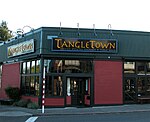Wallingford Fire and Police Station
Buildings and structures completed in 1913Fire stations on the National Register of Historic Places in Washington (state)National Register of Historic Places in SeattlePolice stations on the National Register of Historic PlacesSeattle Fire Department ... and 1 more
Washington (state) Registered Historic Place stubs

The Wallingford Fire and Police Station, also known as the Wallingford Police Precinct Station, at 1629 N. 45th St. in Seattle, Washington was built in 1913. It was listed on the National Register of Historic Places in 1983.It was designed by architect Daniel Riggs Huntington. It is a two-story 62 by 85 feet (19 m × 26 m) wood-frame building with a partial basement. It was built in 1913, then modified in 1921 when horse-drawn equipment was retired, then remodelled again in 1965.
Excerpt from the Wikipedia article Wallingford Fire and Police Station (License: CC BY-SA 3.0, Authors, Images).Wallingford Fire and Police Station
Wallingford Avenue North, Seattle Wallingford
Geographical coordinates (GPS) Address Phone number Website Nearby Places Show on map
Geographical coordinates (GPS)
| Latitude | Longitude |
|---|---|
| N 47.661666666667 ° | E -122.33583333333 ° |
Address
QFC (QFC)
Wallingford Avenue North 4500
98103 Seattle, Wallingford
Washington, United States
Open on Google Maps






